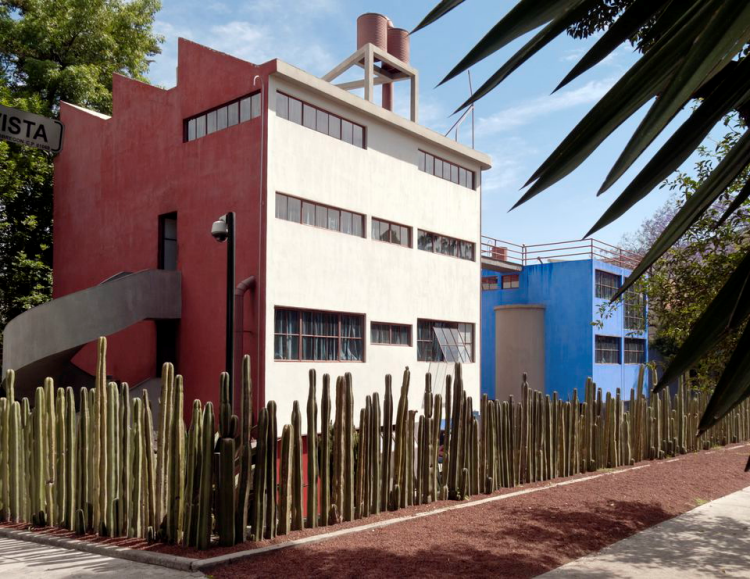***
Kahlo poses inside and in the cactus garden of the paired home/studios designed by architect Juan O'Gorman and which she shared with her husband Diego Rivera until their divorce in 1939. Restored in 1997 it is now a museum dedicated to the two artists.The San Ángel compound, which marked the operatic birth of modern architecture in Mexico, was designed in 1930 by O'Gorman, then 25. The architect came to Rivera's attention after he built his own simple, glass-fronted modern house in the town. Inspired by a studio designed by Le Corbusier in Paris, his plan for the Riveras' studios was more robust and extroverted. The bold volumes, clay-brick ceilings and cantilevered floors and stairs are punctuated by proudly displayed water tanks and downspouts. A southern sun ignites the intense blue and red that are taken straight from vernacular buildings. Working together, O'Gorman, Rivera and Kahlo made Mexican modernism, unlike its European counterpart, warm to the touch.
The modernist imagination has long been a major issue among artists in Mexico resistant to cultural colonization. The tension between being Mexican and modern plays itself out in these three houses [the other two being the famous Casa Azul in nearby Coyoacán, where Kahlo was born and died and where the couple lived after their remarriage in 1940, and the Aztec-Tolmec house-studio in Anahuacalli, finished after Rivera's death in 1957] belonging to artists whose left-wing politics led them and their architect to nationalize the International style. In 1922, Rivera left Paris, where he had befriended Picasso and taken up Cubism, for a postrevolutionary, socially conscious Mexico. He turned to a populist realism that mythologized the nation's Indian past. Even his palette became earthier and brighter, with blood red, copper brown and the azure of the country's sky. Rivera and Kahlo's buildings, and even O'Gorman's other designs, moved from the abstract to the mythic, and the arc of their change starts in San Ángel with the galvanizing blue and red.
Given Rivera's emotional past, crowded with liaisons (including Paulette Goddard, Louise Nevelson and Frida Kahlo's younger sister, Cristina), separate studios for the two painters amounted to spatial wisdom. O'Gorman designed a large glass-walled red studio at the front of the property for Rivera and a smaller blue building at the back for Kahlo, next to a studio for her father, an architectural photographer. ''The architect thought like a psychologist and decided that Frida needed to live alone,'' said Blanca Garduño, director of the Diego Rivera Studio Museum, in the San Ángel house.
Kahlo's studio is the more private of the two. Rivera's double-height studio was on the third floor, beneath the same saw-tooth factory skylights that Le Corbusier used in Paris. Their two-story living room and dining area on the second floor of the front building became a salon for the international avant-garde, where Rivera and Kahlo entertained their bohemian friends. Tubular steel furniture was supplanted by brightly colored peasant furniture, which remains in the house. Dedicated to reviving Mexican traditions, Rivera and Kahlo bridged the progressive and the primitive.
A strikingly cantilevered stair leads to a roof terrace on Kahlo's studio. The buildings are raised on columns that give the forms visual breathing room. The shock value of these bold blocks in a culture devoted to decorative styles borrowed from the European past must have pleased Rivera.
''Besides the influence of Le Corbusier, you can feel the influence of Soviet ideas,'' said Victor Jiménez, who as the former director of architecture in the National Institute of Fine Arts was responsible for the restoration of the San Ángel house. ''The exposed pipes and chimneys were very machinelike and close to the sensibility of the Russian avant-garde. It's a very interesting interpretation of functionalism.''
Photographs taken by Kahlo's father, Guillermo Kahlo, a German emigré, served as archival documents that helped re-establish the home as it looked in 1932. ''We reinstalled the original electrical cabling so that it was plain to see,'' said Mr. Jiménez, now head of a literary foundation, ''and restored the water tanks and metallic trash ducts, which had disappeared.'' The strong colors, which leap off the walls, must have been defiant when the house was built. The blue used was most often associated with cantinas, and was considered in bad taste.
In 1940, Kahlo, who had been injured in a streetcar accident when she was young, left the San Ángel home and retreated to her paternal house, the Blue House [the Casa Azul], now the Frida Kahlo Museum, in Coyoacán. ''She was very angry in the San Ángel house, because she felt she suffered there in two ways,'' Ms. Garduño said. ''Physically, because of her fragile condition, it became very difficult to walk upstairs, and emotionally, her heart suffered because of all the women who visited Diego. She realized that Diego had to make love, because these relationships were one way, with all his financial pressures, for him to promote his work.''












Imagenes llamativas. Los de una mujer rasgos fuertes decidida y extrordinaria. Como una dama noble.
ReplyDeleteIvan Dmitri revela la esencia de Frida Kahlo, una mujer orgullosa de si misma y de la cultura de su nacion.
Y que estudio tan moderno para dos grandes artistas. -Rj/IE